Prashant Goswami, Christopher Batty
Proceedings Short Papers, Eurographics, 45-48, 2014 [PDF]

This paper presents novel and efficient strategies to spatially adapt the amount of computational effort applied
based on the local dynamics of a free surface flow, for classic weakly compressible SPH (WCSPH). Using a
convenient and readily parallelizable block-based approach, different regions of the fluid are assigned differing
time steps and solved at different rates to minimize computational cost. We demonstrate that our approach can
achieve about two times speed-up over the standard method even in highly dynamic scenes.
An Interactive Computational Design Tool for Large Reciprocal Frame Structures
Peng Song, Chi-Wing Fu, Prashant Goswami, Jianmin Zheng, Niloy J. Mitra, Daniel Cohen-Or
Nexus Network Journal (NNJ), To Appear 2014 [PDF]
This paper presents the detail of our interactive tool for designing reciprocal frame (RF) structures. In general, our tool addresses the RF design problem with
three major steps: (1) it supports the design of RF-tessellation by connecting RF patterns and plane tiling; (2) it delivers interactive preview and exploration of
RF designs in 3D space through conformal mapping; and (3) it performs a novel optimization method to arrange the rods in the RF-structures, so that we can ensure
rod collinear contacts in the structures. This paper supplements our previous work with implementation details, user interface design and operations, as well as
a preliminary study and various new results we devised from the tool.
Reciprocal Frame Structures Made Easy
Peng Song*, Chi-Wing Fu*, Prashant Goswami, Jianmin Zheng, Niloy J. Mitra, Daniel Cohen-Or (*: joint first authors)
ACM Transactions on Graphics (TOG) - SIGGRAPH 2013 Conference Proceedings (TOG) Volume 32 Issue 4, Article No. 94, July 2013 [PDF]
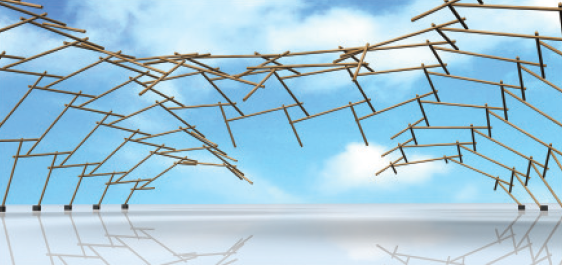
A reciprocal frame (RF) is a self-supported three-dimensional structure made up of three or more sloping rods, which form a closed circuit,
namely an RF-unit. Large RF-structures built as complex grillages of one or a few similar RF-units have an intrinsic beauty derived from their inherent self-similar and
highly symmetric patterns. Designing RF-structures that span over large domains is an intricate and complex task. In this paper, we present an interactive computational
tool for designing RF-structures over a 3D guiding surface, focusing on the aesthetic aspect of the design.
There are three key contributions in this work. First, we draw an analogy between RF-structures and plane tiling with regular polygons, and develop a computational
scheme to generate coherent RF-tessellations from simple grammar rules. Second, we employ a conformal mapping to lift the 2D tessellation over a 3D guiding surface,
allowing a real-time preview and efficient exploration of wide ranges of RF design parameters. Third, we devise an optimization method to guarantee the collinearity
of contact joints along each rod, while preserving the geometric properties of the RF-structure. Our tool not only supports the design of wide variety of RF pattern
classes and their variations, but also allows preview and refinement through interactive controls.
An efficient multi-resolution framework for high quality interactive rendering of massive point clouds using multi-way kd-trees
Prashant Goswami, Fatih Erol, Rahul Mukhi, Renato Pajarola, Enrico Gobbetti
The Visual Computer 29(1):69-83, 2013 (Accepted 2012) [PDF]
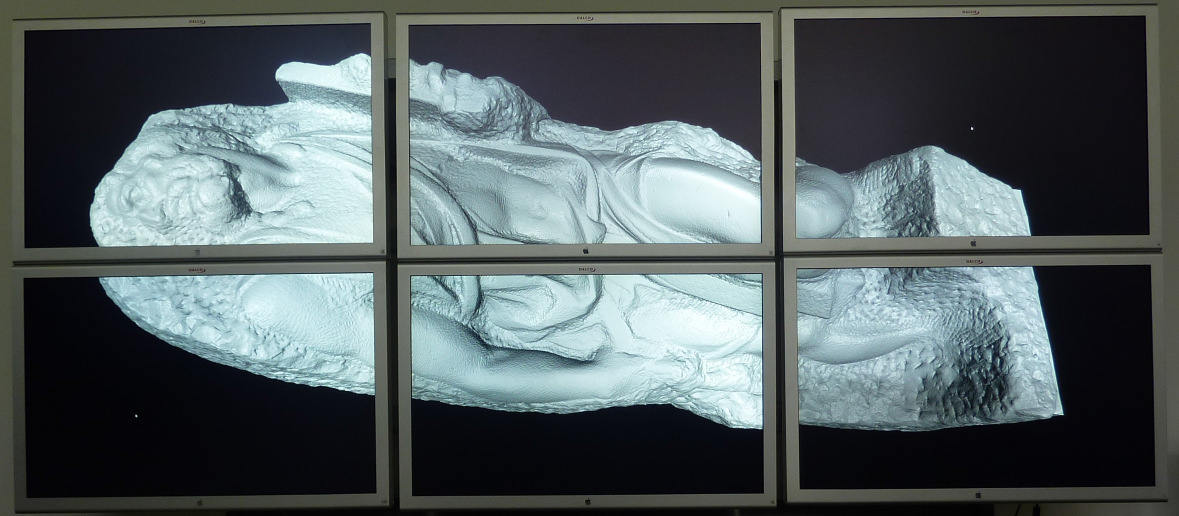
We present an efficient technique for out-of-core multi-resolution construction and high quality
interactive visualization of massive point clouds. Our approach introduces a novel hierarchical level of detail
(LOD) organization based on multi-way kd-trees, which simplifies memory management and allows control over the LOD-tree height.
The LOD tree, constructed bottom up using a fast high-quality point simplification method, is fully balanced and contains all
uniformly sized nodes. To this end, we introduce and analyze three efficient point simplification approaches
that yield a desired number of high-quality output points. For constant rendering performance, we propose an efficient
rendering-on-a-budget method with asynchronous data loading, which delivers fully continuous high quality rendering through
LOD geo-morphing and deferred blending. Our algorithm is incorporated in a full end-to-end rendering system, which
supports both local rendering and cluster-parallel distributed rendering. The method is evaluated on complex models made of hundreds
of millions of point samples.
Time Adaptive Approximate SPH
Prashant Goswami, Renato Pajarola
Workshop in Virtual Reality Interactions and Physical Simulation (VRIPHYS), 19-28, 2011 [PDF]
In this paper, we present two different techniques to accelerate and approximate particle-based fluid simulations.
The first technique identifies and employs larger time steps than dictated by the CFL condition. The second introduces
the concept of approximation in the context of particle advection. For that, the fluid is segregated into active
and inactive particles, and a significant amount of computation is saved on the passive particles. Using these two
optimization techniques, our approach can achieve up to 7 times speed-up compared to a standard SPH method
and it is compatible with other SPH improvement methods. We demonstrate the effectiveness of our method using
up to one million particles and also compare it to standard SPH particle simulation visually and statistically.
Interactive SPH Simulation and Rendering on the GPU
Prashant Goswami, Philipp Schlegel, Barbara Solenthaler, Renato Pajarola [PDF]
ACM/Eurographics Symposium on Computer Animation (SCA), 55-64, 2010
In this paper we introduce a novel parallel and interactive SPH simulation and rendering method on the GPU
using CUDA which allows for high quality visualization. The crucial particle neighborhood search is based on
Z-indexing and parallel sorting which eliminates GPU memory overhead due to grid or hierarchical data structures.
Furthermore, it overcomes limitations imposed by shading languages allowing it to be very flexible and
approaching the practical limits of modern graphics hardware. For visualizing the SPH simulation we introduce a
new rendering pipeline. In the first step, all surface particles are efficiently extracted from the SPH particle cloud
exploiting the simulation data. Subsequently, a partial and therefore fast distance field volume is rasterized from
the surface particles. In the last step, the distance field volume is directly rendered using state-of-the-art GPU
raycasting. This rendering pipeline allows for high quality visualization at very high frame rates.
High Quality Interactive Rendering of Massive Point Models Using Multi-way kd-Trees
Prashant Goswami, Yanci Zhang, Renato Pajarola, Enrico Gobbetti
18th Pacific Conference on Computer Graphics and Applications (PG), 93-100, 2010 [PDF]
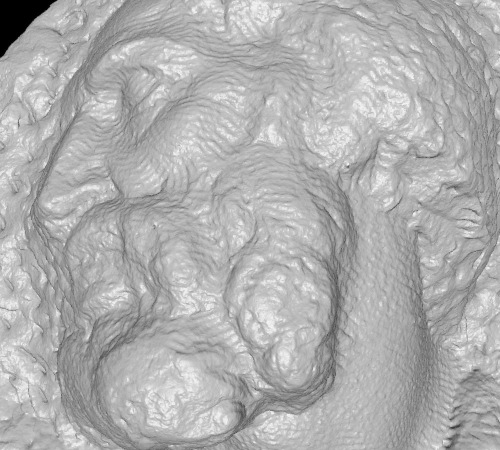
We present a simple and efficient technique for out-of-core multi resolution construction and high quality visualization of large point datasets.
The method introduces a novel hierarchical LOD data organization based on multi-way kd-trees that simplifies memory management and allows controlling the LOD tree's height.
The technique is incorporated in a full end-to-end system, which is evaluated on complex models made of hundreds of millions of points.
Scalable Parallel Out-of-Core Terrain Rendering
Prashant Goswami, Maxim Makhinya, Jonas Bösch, Renato Pajarola
Proceedings of the 10th Eurographics conference on Parallel Graphics and Visualization (EGPGV), 63-71, 2010 [PDF]
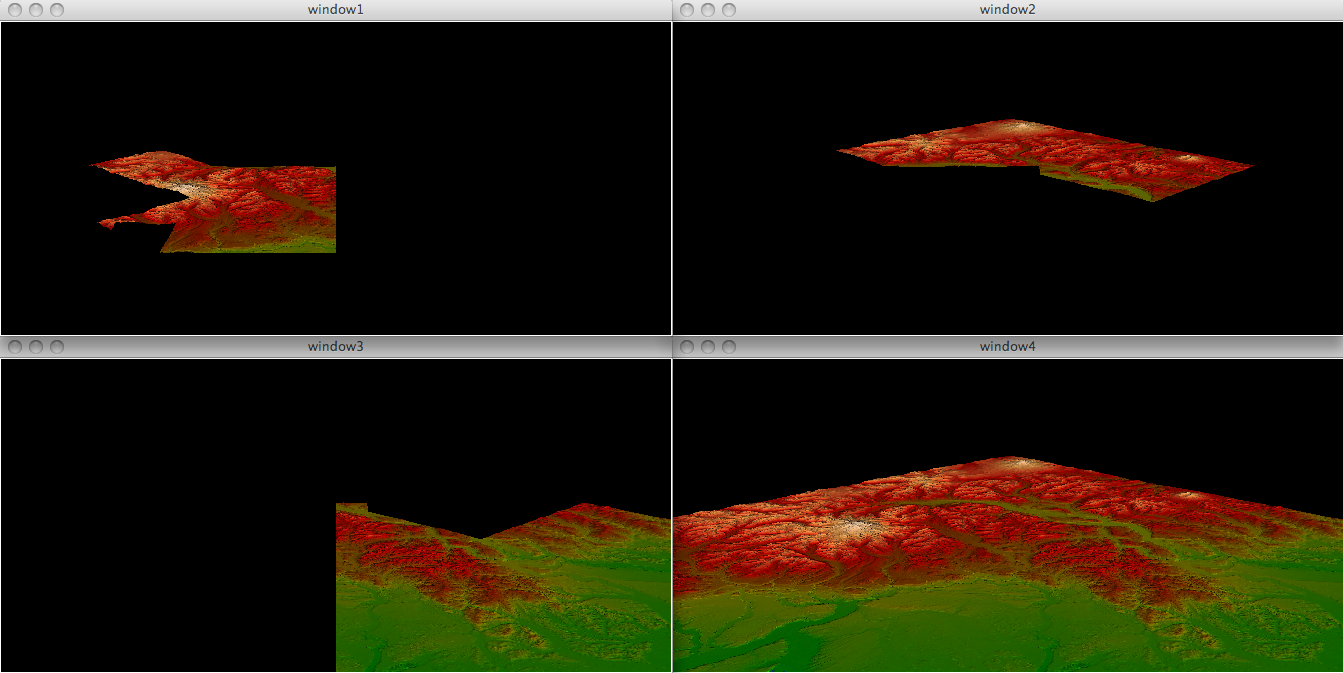
In this paper, we introduce a novel out-of-core parallel and scalable technique for rendering massive terrain
datasets. The parallel rendering task decomposition is implemented on top of an existing terrain renderer using
an open source framework for cluster-parallel rendering. Our approach achieves parallel rendering by division
of the rendering task either in sort-last (database) or sort-first (screen domain) manner and presents an optimal
method for implicit load balancing in the former mode. The efficiency of our approach is validated using massive
elevation models.
RASTeR: Simple and Efficient Terrain Rendering on the GPU
Jonas Bösch, Prashant Goswami, Renato Pajarola
Eurographics Area Paper, 35-42, 2009 [PDF]
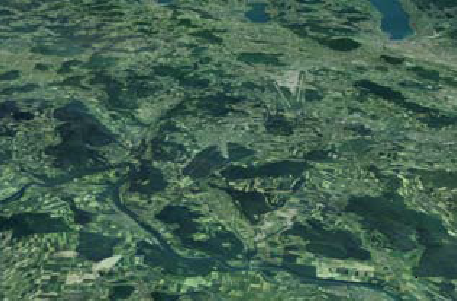
This paper introduces RASTeR, a GPU based LOD technique for interactive rendering of large terrains based on
a paired multi-resolution tree structure. Our approach uses regular height-data blocks and terrain independent
triangle patches, which are used to efficiently subdivide the terrain data. At run time, continuous LODs can simply
be generated by tiling a limited set of triangle patches, the indices to which are pre-computed, over height-field
blocks, thereby minimizing the amount of data to be transferred to the graphics card. RASTeR maintains a constant
frame rate through asynchronous and a priori fetching of raw or compressed elevation and texture data. The
efficiency of our method is validated by presenting experimental results on large elevation models.